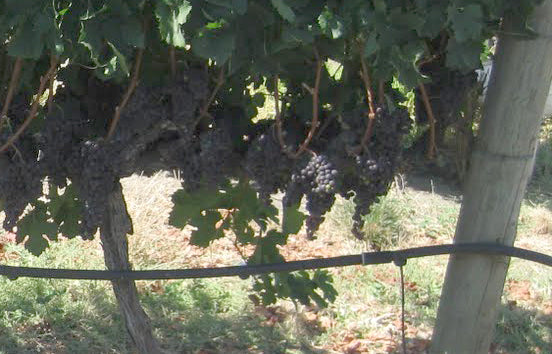Great Wine is in the Details

 Let’s focus on Napa Valley and Cabernet for the rest of this article. In the central valley where the majority of grapes are pruned and harvested mechanically, they farm for quantity not quality. They spray indiscriminately for pests and weeds and they water routinely, with preset times. The average tonnage per acre in the Central Valley is about 8 to 10 tons of grapes per acre.
Meanwhile, in Napa the cabernet grapes are planted close together to bring down the yields. When the grapes first start to form the vineyard workers literally go through the vines and drop whole clusters of grapes so that there is only one or two clusters per shoot. Many vineyards will do yet another pass near harvest and drop even more fruit. Thus the average tonnage per acre in Napa is 1.5 to 2 tons per acre in the mountains, and 4 tons per acre on the valley floor- a far cry from the average tonnage in the Central Valley. The fruit that is dropped is left on the ground as compost.
Let’s focus on Napa Valley and Cabernet for the rest of this article. In the central valley where the majority of grapes are pruned and harvested mechanically, they farm for quantity not quality. They spray indiscriminately for pests and weeds and they water routinely, with preset times. The average tonnage per acre in the Central Valley is about 8 to 10 tons of grapes per acre.
Meanwhile, in Napa the cabernet grapes are planted close together to bring down the yields. When the grapes first start to form the vineyard workers literally go through the vines and drop whole clusters of grapes so that there is only one or two clusters per shoot. Many vineyards will do yet another pass near harvest and drop even more fruit. Thus the average tonnage per acre in Napa is 1.5 to 2 tons per acre in the mountains, and 4 tons per acre on the valley floor- a far cry from the average tonnage in the Central Valley. The fruit that is dropped is left on the ground as compost.
 Unlike the Central Valley, watering in Napa and Sonoma is not done according to a timer. Because water is such a precious resource, the vines get only what they need albeit just barely. Not only does this “stress” the vines which produces a higher quality grape, but it forces the grapevine’s roots to seek water on it’s own. A grapevine can go down as much as 30 feet in search of water. When irrigation is needed, the entire vineyard is not watered, only those blocks that need them. The only way to figure out which blocks need water is to walk the vineyard and take sample from the leaves.
When it comes to harvest, the same care is taken. Rarely in a small high quality vineyard are grapes harvested the same day. It stands to reason that merlot and cabernet may ripen at different times thus the need to be picked on different days. However, grapes ripen differently in the vineyard based on the soil in that spot of the vineyard, the way the sun shines on that spot, the wind, etc. So therefore even the same varietal may be harvested at different times. I know of vineyards that do up to eight passes just for cabernet alone.
But the careful attention to detail goes beyond watering, harvesting, and fruit yields. Most vineyards, especially small ones, all farm sustainably. Just because they aren’t certified organic doesn’t mean they aren’t using owl boxes, beneficial insects, bats, and a host of other natural ways to control and manage their land. All of this costs money.
So when purchasing wine keep in mind that you really do get what you pay for. A higher price usually means attention to detail, hands on farming, and overall a higher quality product.
VinoLatinoUSA.com
Unlike the Central Valley, watering in Napa and Sonoma is not done according to a timer. Because water is such a precious resource, the vines get only what they need albeit just barely. Not only does this “stress” the vines which produces a higher quality grape, but it forces the grapevine’s roots to seek water on it’s own. A grapevine can go down as much as 30 feet in search of water. When irrigation is needed, the entire vineyard is not watered, only those blocks that need them. The only way to figure out which blocks need water is to walk the vineyard and take sample from the leaves.
When it comes to harvest, the same care is taken. Rarely in a small high quality vineyard are grapes harvested the same day. It stands to reason that merlot and cabernet may ripen at different times thus the need to be picked on different days. However, grapes ripen differently in the vineyard based on the soil in that spot of the vineyard, the way the sun shines on that spot, the wind, etc. So therefore even the same varietal may be harvested at different times. I know of vineyards that do up to eight passes just for cabernet alone.
But the careful attention to detail goes beyond watering, harvesting, and fruit yields. Most vineyards, especially small ones, all farm sustainably. Just because they aren’t certified organic doesn’t mean they aren’t using owl boxes, beneficial insects, bats, and a host of other natural ways to control and manage their land. All of this costs money.
So when purchasing wine keep in mind that you really do get what you pay for. A higher price usually means attention to detail, hands on farming, and overall a higher quality product.
VinoLatinoUSA.com
Leave a comment
Comments will be approved before showing up.




